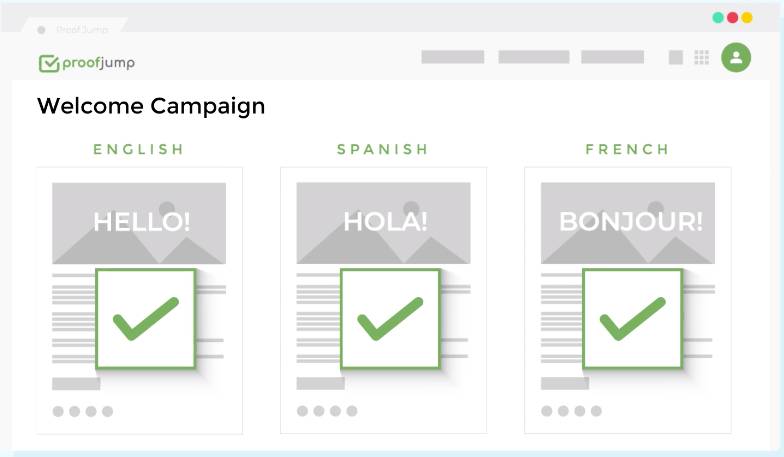
How to Proof Mutlilingual Campaigns and Improve Localized Email Marketing Results
Using dynamic content in your email marketing campaigns can boost open rates by up to 73%, and if you’re sending multilingual campaigns so recipients receive your email messages in their native languages, dynamic content is a must.
Considering that 72.4% of consumers are more likely to buy a product when information is provided in their native language, it’s imperative that your email marketing messages are written in the language that each recipient prefers.
For example, did you know Canada is officially bilingual? Some regions use both languages while others use just one. And if you’re sending messages to people in Europe, it’s important to know that most campaigns in Europe are multilingual.
But that’s not all.
While creating email campaigns in multiple languages is the most obvious way to localize your campaigns, that’s just the beginning. When you’re sending email marketing messages to people who speak different languages, you need to consider a significantly longer list of localization factors.
Fortunately, you can quickly and easily create highly localized email marketing campaigns using dynamic content.
Using Multiple Languages and Creating Localized Email Campaigns with Dynamic Content
At a minimum, you should make sure the following localization elements are appropriate and accurate for each recipient based on their language and local culture:
- Language translations are accurate.
- Images and colors are appropriate.
- Messaging is effective, and the copy has been translated so the meaning, emotional triggers, calls to action, and so on are effective based on the language, culture, etc.
- Messaging isn’t insensitive, inappropriate, or offensive based on culture, localization, etc.
- Links lead to a web page written in the same language as the email message.
- Message adheres to local laws (e.g., privacy laws, email communication laws, etc.).
- Grammar, formatting, and punctuation are accurate based on the language (e.g., LTR and RTL script design).
You can use dynamic content to automatically display the right localized content to each of your target audiences, which saves time and gives you peace-of-mind that the right people will receive the right messages.
Keep in mind, often when English is translated to other languages, the new text can be up to 25% longer. It’s highly likely that you’ll need to modify your designs and layouts to fit translated text, so make sure all of your message variants in your multilingual campaigns render correctly in all email inboxes (mobile and desktop).
Proofing Dynamic Content in Localized Campaigns Using Automated Labels
Creating localized email messages is just the first step to ensuring those messages convert. You also need each of your stakeholders to proof and approve those messages, and for localized campaigns with numerous variations, the proofing and approval process can become confusing and time-consuming.
That’s why it’s important to use a tool like ProofJump to proof and approve multilingual campaigns using dynamic content.
Once you’ve identified your audience segments and who should receive which version of your email campaign based on language and localization, you can use ProofJump’s Automated Label Proofing feature to allow reviewers and stakeholders to proof and approve each variant quickly and efficiently.
Simply create unique dynamic content identifiers for each variant to use as labels. These labels tag your email messages based on the criteria you choose, such as segment ID or a recipient attribute (e.g., language).
For example, if you’re sending a message to recipients in multiple regions of Canada, which have both English and French-speaking populations, you can create dynamic content identifiers to tag your messages based on each recipient’s preferred language.
Next, you can insert the unique dynamic content identifier into your test emails, and ProofJump will automatically label each variant with the identifier.
Finally, just share the campaign link with your reviewers and stakeholders, and they can easily review, add feedback, proof, and approve every variant without any confusion or delays.
All messages and variants are updated in real-time, so you can rest-assured that everyone is reviewing the most recent version of your localized campaigns.
Take a look at the image below, which shows how a multilingual campaign with multiple variants using dynamic content would look to reviewers in the ProofJump software. Each variant is clearly labeled and easy for reviewers to identify.

It’s so easy to use this set up to review multiple languages and localized email marketing campaigns!
Key Takeaways about Localized Email Marketing and Proofing Dynamic Content
Just as you shouldn’t rely on an inadequate tool like Google Translate to translate your campaigns into multiple languages, you shouldn’t rely on an ineffective tool to proof and approve them.
Use dynamic content and a tool like ProofJump to reduce errors, cut costs, boost productivity, and improve your localized campaign results.
Schedule a demo to see how easy it is to proof dynamic content and localized campaigns with ProofJump.
Image by Gerd Altmann from Pixabay
